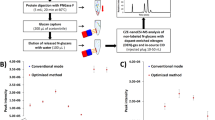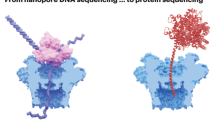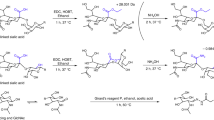Abstract
Here we provide a detailed protocol for the analysis of protein-linked glycans on DNA sequencing equipment. This protocol satisfies the glyco-analytical needs of many projects and can form the basis of 'glycomics' studies, in which robustness, high throughput, high sensitivity and reliable quantification are of paramount importance. The protocol routinely resolves isobaric glycan stereoisomers, which is much more difficult by mass spectrometry (MS). Earlier methods made use of polyacrylamide gel–based sequencers, but we have now adapted the technique to multicapillary DNA sequencers, which represent the state of the art today. In addition, we have integrated an option for HPLC-based fractionation of highly anionic 8-amino-1,3,6-pyrenetrisulfonic acid (APTS)-labeled glycans before rapid capillary electrophoretic profiling. This option facilitates either two-dimensional profiling of complex glycan mixtures and exoglycosidase sequencing, or MS analysis of particular compounds of interest rather than of the total pool of glycans in a sample.
This is a preview of subscription content, access via your institution
Access options
Subscribe to this journal
Receive 12 print issues and online access
$259.00 per year
only $21.58 per issue
Buy this article
- Purchase on Springer Link
- Instant access to full article PDF
Prices may be subject to local taxes which are calculated during checkout




Similar content being viewed by others
References
Guttman, A. & Pritchett, T. Capillary gel electrophoresis separation of high-mannose type oligosaccharides derivatized by 1-aminopyrene-3,6,8-trisulfonic acid. Electrophoresis 16, 1906–1911 (1995).
Jackson, P. The use of polyacrylamide-gel electrophoresis for the high-resolution separation of reducing saccharides labelled with the fluorophore 8-aminonaphthalene-1,3,6-trisulphonic acid. Detection of picomolar quantities by an imaging system based on a cooled charge-coupled device. Biochem. J. 270, 705–713 (1990).
Evangelista, R.A., Guttman, A. & Chen, F.T. Acid-catalyzed reductive amination of aldoses with 8-aminopyrene-1,3,6- trisulfonate. Electrophoresis 17, 347–351 (1996).
Callewaert, N., Geysens, S., Molemans, F. & Contreras, R. Ultrasensitive profiling and sequencing of N-linked oligosaccharides using standard DNA-sequencing equipment. Glycobiology 11, 275–281 (2001).
Papac, D.I., Briggs, J.B., Chin, E.T. & Jones, A.J. A high-throughput microscale method to release N-linked oligosaccharides from glycoproteins for matrix-assisted laser desorption/ionization time-of-flight mass spectrometric analysis. Glycobiology 8, 445–454 (1998).
Packer, N.H., Lawson, M.A., Jardine, D.R. & Redmond, J.W. A general approach to desalting oligosaccharides released from glycoproteins. Glycoconj. J. 15, 737–747 (1998).
Ludwiczak, P., Brando, T., Monsarrat, B. & Puzo, G. Structural characterization of Mycobacterium tuberculosis lipoarabinomannans by the combination of capillary electrophoresis and matrix-assisted laser desorption/ionization time-of-flight mass spectrometry. Anal. Chem. 73, 2323–2330 (2001).
Suzuki, H., Muller, O., Guttman, A. & Karger, B.L. Analysis of 1-aminopyrene-3,6,8-trisulfonate-derivatized oligosaccharides by capillary electrophoresis with matrix-assisted laser desorption/ionization time-of-flight mass spectrometry. Anal. Chem. 69, 4554–4559 (1997).
Sandra, K. et al. Characterization of cellobiohydrolase I N-glycans and differentiation of their phosphorylated isomers by capillary electrophoresis-q-trap mass spectrometry. Anal. Chem. 76, 5878–5886 (2004).
Anumula, K.R. High-sensitivity and high-resolution methods for glycoprotein analysis. Anal. Biochem. 283, 17–26 (2000).
Raman, R., Raguram, S., Venkataraman, G., Paulson, J.C. & Sasisekharan, R. Glycomics: an integrated systems approach to structure-function relationships of glycans. Nat. Methods. 2, 817–824 (2005).
Breitling, R. et al. Non-pathogenic trypanosomatid protozoa as a platform for protein research and production. Protein Expr. Purif. 25, 209–218 (2002).
Defrancq, L., Callewaert, N., Zhu, J., Laroy, W. & Contreras, R. DSA-FACE: high-throughput analysis of the N-glycans of NS0-cell secreted antibodies. Bioprocess Int. 6, 60–68 (2004).
Reeves, P.J., Callewaert, N., Contreras, R. & Khorana, H.G. Structure and function in rhodopsin: high-level expression of rhodopsin with restricted and homogeneous N-glycosylation by a tetracycline-inducible N-acetylglucosaminyltransferase I-negative HEK293S stable mammalian cell line. Proc. Natl. Acad. Sci. USA 99, 13419–13424 (2002).
Vervecken, W. et al. In vivo synthesis of mammalian-like, hybrid-type N-glycans in Pichia pastoris. Appl. Environ. Microbiol. 70, 2639–2646 (2004).
Callewaert, N. et al. Noninvasive diagnosis of liver cirrhosis using DNA sequencer-based total serum protein glycomics. Nat. Med. 10, 429–434 (2004).
Maras, M. et al. Molecular cloning and enzymatic characterization of a Trichoderma reesei 1,2-α-D-mannosidase. J. Biotechnol. 77, 255–263 (2000).
He, Z., Aristoteli, L.P., Kritharides, L. & Garner, B. HPLC analysis of discrete haptoglobin isoform N-linked oligosaccharides following 2D-PAGE isolation. Biochem. Biophys. Res. Commun. 343, 496–503 (2006).
O'Shea, M.G. & Morell, M.K. High resolution slab gel electrophoresis of 8-amino-1,3, 6-pyrenetrisulfonic acid (APTS) tagged oligosaccharides using a DNA sequencer. Electrophoresis 17, 681–686 (1996).
Khandurina, J., Olson, N.A., Anderson, A.A., Gray, K.A. & Guttman, A. Large-scale carbohydrate analysis by capillary array electrophoresis: part 1. Separation and scale-up. Electrophoresis 25, 3117–3121 (2004).
Vogel, K., Kuhn, J., Kleesiek, K. & Gotting, C. A novel ultra-sensitive method for the quantification of glycosaminoglycan disaccharides using an automated DNA sequencer. Electrophoresis 27, 1363–1367 (2006).
Wing, D.R. et al. High-performance liquid chromatography analysis of ganglioside carbohydrates at the picomole level after ceramide glycanase digestion and fluorescent labeling with 2-aminobenzamide. Anal. Biochem. 298, 207–217 (2001).
Tretter, V., Altmann, F. & Marz, L. Peptide-N4-(N-acetyl-β-glucosaminyl)asparagine amidase F cannot release glycans with fucose attached α1-3 to the asparagine-linked N-acetylglucosamine residue. Eur. J. Biochem. 199, 647–652 (1991).
Elbers, I.J. et al. Influence of growth conditions and developmental stage on N-glycan heterogeneity of transgenic immunoglobulin G and endogenous proteins in tobacco leaves. Plant Physiol. 126, 1314–1322 (2001).
Acknowledgements
We thank A. Van Hecke for technical assistance and A. Bredan for manuscript editing. W. Declercq critically read the protocol. We thank M. Aebi (ETH Zurich) for the use of the ABI 310 System. W.L. is a postdoctoral fellow with the Institute for the Promotion of Innovation by Science and Technology in Flanders (IWT-Vlaanderen; grant IWT/OZM/040636). N.C. is supported by a Marie Curie Excellence Grant of the European Union (Framework Programme 6). This work was further supported by the Fund for Scientific Research Flanders (FWO-Vlaanderen; G005201) and a grant from Ghent University (BOF No. 01106205).
Author information
Authors and Affiliations
Contributions
N.C. and W.L. designed and optimized the technology and wrote the manuscript. R.C. participated in the design of the method.
Corresponding author
Ethics declarations
Competing interests
The authors declare no competing financial interests.
Rights and permissions
About this article
Cite this article
Laroy, W., Contreras, R. & Callewaert, N. Glycome mapping on DNA sequencing equipment. Nat Protoc 1, 397–405 (2006). https://doi.org/10.1038/nprot.2006.60
Published:
Issue Date:
DOI: https://doi.org/10.1038/nprot.2006.60
This article is cited by
-
High-throughput N-glycan screening method for therapeutic antibodies using a microchip-based DNA analyzer: a promising methodology for monitoring monoclonal antibody N-glycosylation
Analytical and Bioanalytical Chemistry (2021)
-
Mechanical strain determines the site-specific localization of inflammation and tissue damage in arthritis
Nature Communications (2018)
-
N-glycosylation of serum proteins for the assessment of patients with IgD multiple myeloma
BMC Cancer (2017)
-
Automated N-Glycosylation Sequencing Of Biopharmaceuticals By Capillary Electrophoresis
Scientific Reports (2017)
-
Abolishment of N-glycan mannosylphosphorylation in glyco-engineered Saccharomyces cerevisiae by double disruption of MNN4 and MNN14 genes
Applied Microbiology and Biotechnology (2017)
Comments
By submitting a comment you agree to abide by our Terms and Community Guidelines. If you find something abusive or that does not comply with our terms or guidelines please flag it as inappropriate.



